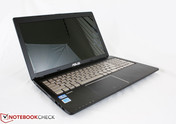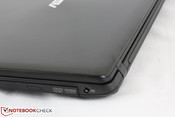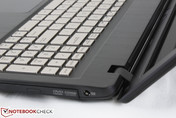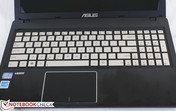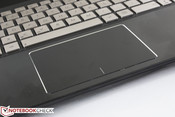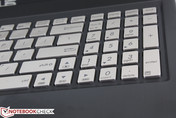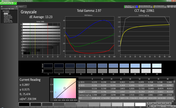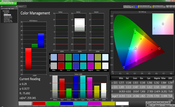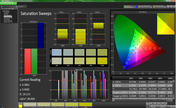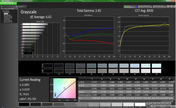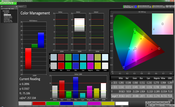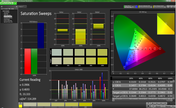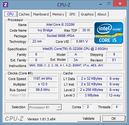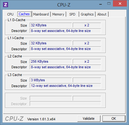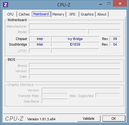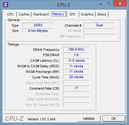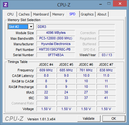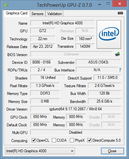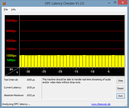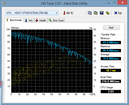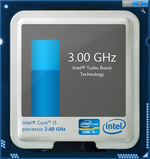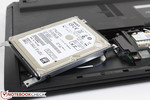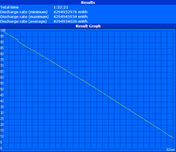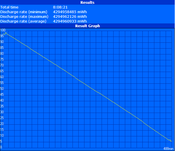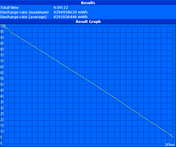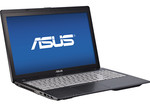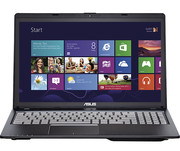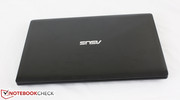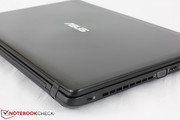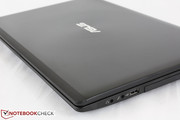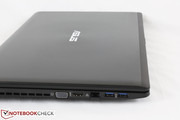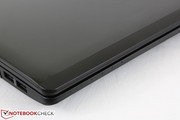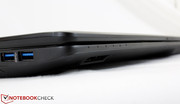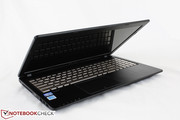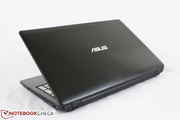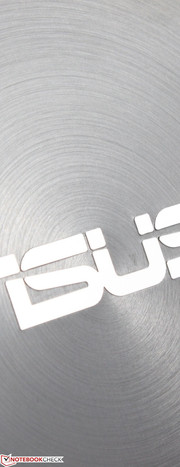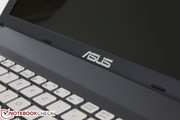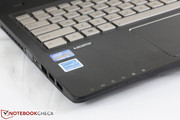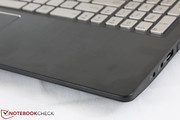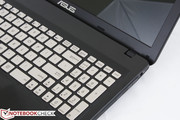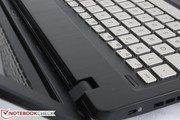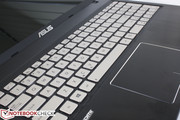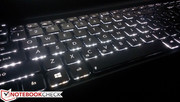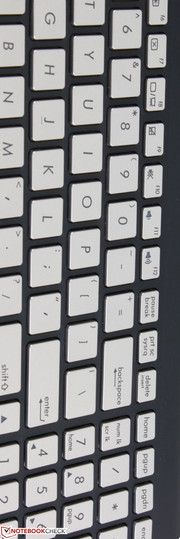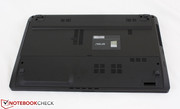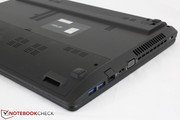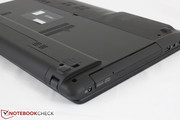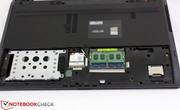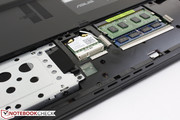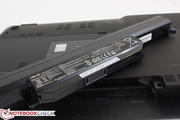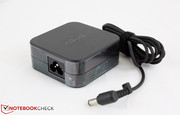Review Asus Q500A-BHI7T05 Notebook

Though Asus has hit a homerun with its classy Zenbook, Transformer, and Taichi series of Ultrabooks and tablets, the manufacturer is not as well-known with regards to its budget or mainstream offerings. This unfortunately results in some potentially great models that may have gone unnoticed or overlooked for those in the market for something more affordable than the recent top sellers.
The Asus Q500A is a great example of an overlooked budget notebook that hits almost all the right spots with regards to performance and build quality for the given price. For $629, the 15.6-inch Q500A as reviewed is equipped with a powerful Core i5-3230M, integrated HD 4000 graphics, 6 GB RAM, 5400 RPM 750 GB HDD and a 1366 x 768 resolution display. A touchscreen version does exist with higher specifications, but its retail cost of over $900 then becomes more difficult to justify against new convertibles and Ultrabooks. The $600 model here is much lighter on the wallet and is overall one of the better deals in its category.
Case
The jet black aluminum case and shape are slightly reminiscent of Asus’ popular ROG series, but the brushed glossy surfaces on the lid and palm rests distinguish the Q500A from an ROG notebook and actually reminds us of the concentric reflections as seen on Transformer products. This cross between an ROG and Transformer makes for a very attractive chassis, even for a notebook that isn’t quite thin enough to meet Ultrabook specifications. Its overall weight (2.5 kg) is in fact only slightly heavier than the budget 15.6-inch Toshiba C850 (2.3 kg) and Acer V5-551 (2.3 kg). The underside of the unit contrasts the rest of the notebook as it is matte and rubberized, a combination of traits that are not normally associated with the budget price range. The main downside to both the glossy and rubber finishing is the ease in which fingerprints will accumulate and the subsequent difficulty in wiping them off. Regardless, the Q500 is a definite step up visually when compared to the normally dull and drab looks of low-end notebooks.
In terms of build quality, the base and palm rests are stiff with very good resistance to twists and pressure. Likewise, the hinges don’t disappoint despite their small size as they hold onto the display with much less wobbling compared to the similarly priced Sony Vaio T14. Twisting of the lid and depressions on the center of the keyboard are both observable, though they are far from extreme to be a cause for concern. Perhaps the weakest attribute of the case is the center of the lid where it is quite easy to warp or depress the surface with applied pressure. Though not as thin or severe as the lid of the Lenovo Y580, we would certainly slip on a protective case before transporting the notebook in a backpack with other adjacent items.
Connectivity
With almost all ports on the sides and none on the rear, most are easy-to-reach and very close up front. This of course has the unfortunate side effect of cables jutting out and occupying valuable desk or mouse space on both sides. The only input on the front edge is the SD card reader, which can be difficult to access due to the slanted build of the front of the chassis. Users with larger fingers may need to lift the notebook first for easier access to the reader. In terms of what is available, the Q500A offers all the usual ports that we expect from a notebook in this price range, including a Gigabit Ethernet port and an optical drive.
Communication
Wireless communication is provided by Intel’s Centrino 2230 half-mini 2x2 WLAN card capable of up to 300 mpbs transfer speeds. We experienced no unexpected dropouts or connectivity issues with both WLAN and the included Bluetooth 4.0. There are no WWAN or GPS options as is expected from a low-cost consumer-oriented model.
Accessories
Dedicated accessories or extensions are not available for the Q500A due to no dedicated ports for docking, though such features are usually reserved for business-oriented models and should not be expected on a budget consumer offering. Generic USB 3.0 docks and other accessories are available directly from Asus if further connectivity options are desired.
Warranty
The usual one-year limited standard warranty applies to the Q500A with extended options available directly from Asus. Users who register the notebook will have additional benefits such as onsite repair and replacement with international options depending on the price. Notably, users do not have to sign up for extended services immediately at purchase, but can choose to apply the warranty at any time within the one-year purchase date.
Input Devices
Keyboard
The Chiclet keyboard (34 cm x 10.5 cm) is quiet with low clatter, yet feedback is adequate and responsive enough for a satisfactory typing experience. Travel is certainly not as deep or solid as say a desktop keyboard or the now-extinct beveled keyboard of older ThinkPads, but we found it easy to become accustomed to the flat silver keys. The numpad and arrow keys, however, are made narrower than the QWERTY keys due to the limited space and feel slightly softer when pressed.
Auxiliary keys, which are common on more multimedia-centric notebooks, are not present here. It would have been useful to have dedicated volume and/or brightness keys instead of relying on the fn key for some basic commands. The power key is also quite close to the Esc key, so hasty users may accidentally hit the power key instead when they intended to hit Esc.
Another noteworthy mention is the keyboard backlight with three levels of brightness. The feature is uncommon on budget notebooks and definitely adds value to the Q500A.
Touchpad
The flat plastic touchpad integrates the usual mouse keys and is actually quite roomy (10.5 cm x 7.5 cm) with a smooth glide. We especially like the chrome perimeter, which is a subtle addition that adds noticeably to the overall aesthetics. Powered by Asus Smart Gesture, the touchpad supports up to 3-finger touch and responds to gestures extremely well with no jumps and few input errors compared to other budget models, especially when scrolling, rotating or zooming.
The left and right click keys, like the keyboard keys, are shallow in travel and quiet when pressed. Feedback is acceptable, but can be a bit spongy as users can still push down on the key and see a depression without the notebook registering the input. Of course, users can still tap once to left click as needed. For situations where an external mouse is not available, we found the touchpad to work without any major issues.
Display
The 1366 x 768 resolution display has been common amongst low-priced 15.6-inch notebooks for years and the Q500A in review is no exception. Note, however, that the $950 Q500A model does include a denser 1080p display in order to rationalize the much higher costs, but both models will have a glossy screen. Subjectively, the 720p display is not as crisp to those accustomed to 1080p or greater devices, but it should get the job done for most home users and sufficient for light-to-moderate workloads.
With the X-Rite i1Basic Pro 2, an average brightness of about 240 nits was measured across nine quadrants. Though it could have been brighter, this is very good for a budget model where displays under 200 nits can be more common, such as the Toshiba C850 and Acer V5-551. Similarly, the contrast is nothing spectacular, but still above average for the price and satisfactory for movies. For a glossy screen where reflections can be prevalent, the screen brightness of the Asus should prove more than enough for most indoor environments.
| |||||||||||||||||||||||||
Brightness Distribution: 86 %
Center on Battery: 260 cd/m²
Contrast: 486:1 (Black: 0.535 cd/m²)
38.25% AdobeRGB 1998 (Argyll 3D)
53.6% sRGB (Argyll 3D)
37.06% Display P3 (Argyll 3D)
Color reproduction is quite poor at only about 50 percent of the sRGB spectrum, or very similar to the display of the Aspire V5-551. The low range excludes the notebook for professional use where accurate and precise colors may be required, but should otherwise be acceptable for everyday use.
Further color analyses were performed with the X-Rite spectral profiler. When uncalibrated, color accuracy was found to be very poor with very high deviations in DeltaE for all colors. Post-calibration results show much more balanced grayscale and gamma. Colors improve as well, though red still deviates quite a bit when compared to other colors at full saturation.
Outdoor usability is average at best. The notebook is almost unusable when under direct sunlight without uncomfortable squinting, but is much more tolerable if under shade. Maximum brightness is highly recommended due to the glossy screen. Note that maximum brightness does not artificially drop when on the Balanced or High Performance profile while the Power Saver profile will reduce the maximum to only 216 nits.
Performance
The model in review houses a standard voltage Ivy Bridge 2.6 GHz Core i5-3230M. The more expensive $950 model uses a quad-core i7-3632QM, though the dual-core i5 should be more than enough for the home user. For more information and benchmarks on the i5-3230M, see our dedicated page here.
RAM is provided by two SODIMM DDR3 modules: 1x 2 GB module from ASint and 1x 4 GB module from Hyundai in dual-channel mode. Both slots are easily accessible via a hatch underneath, which also exposes the 2.5-inch HDD and WLAN card.
DPC Latency Checker shows no recurring high latency peaks even with wireless radios active. The program is not yet fully compatible with Windows 8, so its results should not be taken as final.
Processor
CPU-oriented benchmarks show the i5-3230M in the Asus to be similar to the Aspire V3-571G in our database, which also houses the same CPU. Compared to the Sandy Bridge generation, the i5-3230M is most similar to the i7-2620M, one of the fastest dual-core CPUs back in 2011. Needless to say, the power that the Q500A provides will be more than enough for browsing and other home tasks.
System Performance
System performance is very good for a notebook with a 5400 RPM drive. At over 3000 points in PCMark 7, the Q500A outscores the Acer V3-571G (2516 points), Sony T14 with SSD cache (2817 points), Toshiba C850 (2093 points), and Acer V5-551 (1201 points). Notebooks with dedicated SSDs will of course outclass the Asus in review, but these will cost users at least a few hundred more.
| PCMark 7 Score | 3017 points | |
Help | ||
Storage Devices
The included 750 GB Travelstar drive does not include any dedicated SSDs for caching, but it should offer more than enough space for most users. According to HD Tune, its average transfer rate of 75.6 MB/s is average for a 5400 RPM drive, though most models will hover closer to 80 MB/s. For example, the 5400 RPM Seagate drives in the Sony T14 and Aspire M3-481 return 77.5 MB/s and 82.2 MB/s in the same benchmark. Faster Travelstar 7200 RPM drives, such as the 750 GB model in the 2012 Envy 15, easily outclass the slow Hitachi in the Q500A.
Fortunately, users can quickly swap out the 9.5 mm drive for a faster model or even an SSD, the latter of which will improve system performance dramatically from the base 5400 RPM drive. The Q500A even offers a SATA III interface for full support for 6 Gb/s drives. For our growing list of HDD and SSD benchmarks, see our table here.
Graphics Card
GPU performance is as expected from the integrated HD 4000 GPU. The latest titles should be playable on low settings while older titles fare much better on the native resolution. Our full review on the HD 4000 can be seen here and additional benchmarks can be seen on its dedicated page here.
| 3DMark 03 Standard | 13137 points | |
| 3DMark 06 Standard Score | 5322 points | |
| 3DMark Vantage P Result | 3235 points | |
| 3DMark 11 Performance | 654 points | |
| 3DMark Ice Storm Standard Score | 42957 points | |
| 3DMark Cloud Gate Standard Score | 4162 points | |
Help | ||
| low | med. | high | ultra | |
|---|---|---|---|---|
| Guild Wars 2 (2012) | 45 | 15 | ||
| StarCraft II: Heart of the Swarm (2013) | 129 | 38 | 21 |
Emissions
System Noise
At almost 35 dB(A) when idle, the fan never stops spinning and will be audible in a quiet environment with almost no ambient noise. Otherwise, a typical office environment will easily drown out the noise and make it essentially inaudible in practice. Heavy CPU or GPU load will increase fan noise by quite a bit, up to almost 40 dB(A), which is definitely noticeable during use. Users who game or have consistently high CPU loads may experience the much louder fan. Thankfully, playback of Youtube videos or other HD content are not enough to induce such high fan speeds.
If under maximum stress, we were able to record fan speeds of over 47 dB(A) – very close to the uncomfortably loud 50 dB(A) range. During normal use, however, we do not expect users to experience such high noise levels.
Noise level
| Idle |
| 34.5 / 34.6 / 34.7 dB(A) |
| DVD |
| 40.8 / 47.2 dB(A) |
| Load |
| 39.1 / 47.2 dB(A) |
 | ||
30 dB silent 40 dB(A) audible 50 dB(A) loud |
||
min: | ||
Temperature
Surface temperatures are on the warm side, even when the system is sitting idle. Interestingly, both the top and bottom sides are quite similar in average temperatures both when idling or under load, possibly due to the very centralized location of the CPU.
Heavy load for an extended period can lead to a very noticeably warm keyboard center – up to 37.8 degrees C in our hour long stress test. This particular spot also happens to be the hottest quadrant on the entire notebook, though the spots nearest the exhaust will be quite warm as well. It’s not uncommon, however, for Ultrabooks to reach even higher surface temperatures north of 40 degrees, such as the X1 Carbon. In practice, we didn’t find the warm keyboard center of the Asus to be an issue while typing.
(+) The maximum temperature on the upper side is 37.8 °C / 100 F, compared to the average of 34.3 °C / 94 F, ranging from 21.2 to 62.5 °C for the class Office.
(+) The bottom heats up to a maximum of 37.4 °C / 99 F, compared to the average of 36.8 °C / 98 F
(+) In idle usage, the average temperature for the upper side is 27.8 °C / 82 F, compared to the device average of 29.5 °C / 85 F.
(+) The palmrests and touchpad are reaching skin temperature as a maximum (34.8 °C / 94.6 F) and are therefore not hot.
(-) The average temperature of the palmrest area of similar devices was 27.6 °C / 81.7 F (-7.2 °C / -12.9 F).
Stress Test
We subject the Q500A to synthetic CPU and GPU loads with monitoring tools (CPU-Z, GPU-Z, HWiNFO) to test for potential throttling issues. Prime95 was used to stress the CPU, but both cores were able to maintain their maximum 3.0 GHz Turbo Boost clock rate without any issues. Similarly, the GPU upheld its 1100 MHz clock without problems with only FurMark active. The CPU settled at around 70 degrees C during the individual tests.
Full stress was simulated with both Prime95 and FurMark active simultaneously. Both the CPU and integrated GPU were able to maintain their respective maximum Turbo Boost clock rates even after a full hour of stress. Core temperature will increase to over 80 degrees C according to HWiNFO, but we experienced no stability issues for the duration of the test. A 3DMark 11 test immediately following the stress test yielded almost unchanged results, confirming no throttling issues with the Q500A.
System performance is not artificially reduced when running on batteries. A 3DMark 06 test without AC power returned almost the exact same scores compared to the same test with the AC adapter connected. This is compared to the recently reviewed Vaio T14 whose integrated GPU in the ULV Core i3 was severely reduced in power when disconnected from the grid.
Speakers
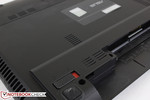
The internal speakers are located on the underbelly of the notebook and emanate towards the table – a less than ideal location for optimal quality. Sound and music feel muffled with poor bass and average balance. Volume can be loud at maximum or close to maximum settings, so users need not to worry about sounds being too soft. For movies and music, however, external solutions are absolutely recommended for a better experience.
Battery Life
All Q500A models ship with a 4700 mAh 50 Wh removable battery; no larger or smaller official options are available. The capacity of the Li-ion battery is good for a budget 15.6-inch notebook as a number of other similarly priced notebooks offer smaller modules like the Toshiba C850 (48 Wh) or Acer V5-551 (37 Wh). Some 15.6-inch models can sport denser batteries, though they typically come with higher prices or more power-hungry discrete graphics. Even so, the notebook returned good runtime numbers according to our Battery Eater tests.
The maximum runtime Reader’s Test returned over 8 hours with the screen set to minimum brightness, wireless disabled, and on the Power Saver profile. Minimum runtime on the Classic Test was about 1.5 hours with maximum brightness and wireless enabled on High Performance. Our more realistic WLAN test puts the notebook on Balanced and on 150 cd/m2 screen brightness (setting 6/10) while looping a script to simulate web browsing. Under these conditions, the notebook clocked out after a solid 4 hours.
Based on the WLAN results, users can expect 4-5 hours of constant use or even 5-6 hours with low activity or reduced settings. The long minimum runtime should allow users who will mainly use the notebook for word processing or the occasional videos to comfortably work away from a power outlet for a good chunk of the day.
Verdict
The Q500A does nothing spectacular, but performs above average in nearly all major categories. While that may not sound too impressive, the low entry price of just $629 is a very good value considering that there are no significant flaws or major dealbreakers that may make users think twice about the quality or performance of this budget model for the price. Users who choose to install an aftermarket SSD will have a notebook that can perform admirably for many years down the line. It’s true that color accuracy, outdoor usability, speakers and maybe even its weight could be better, but the fantastic build quality, fast CPU performance, and keyboard backlight are a rare find in this price range and make this Asus a gem against its competitors.




